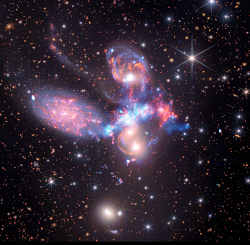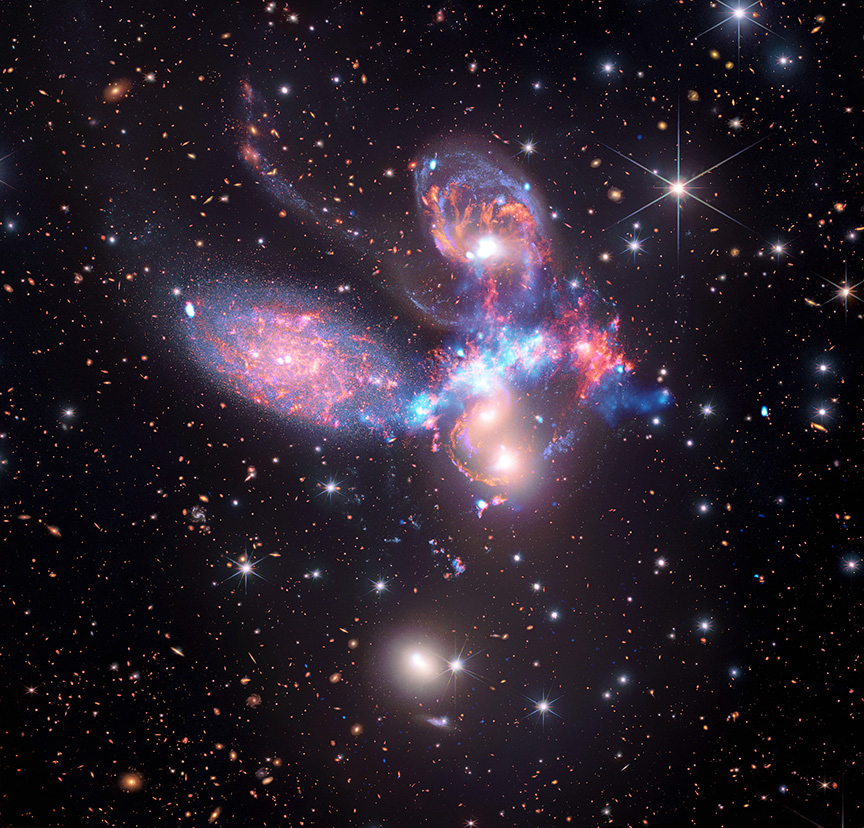Find out the latest thinking about our universe.
-
bystander
- Apathetic Retiree
- Posts: 21587
- Joined: Mon Aug 28, 2006 2:06 pm
- Location: Oklahoma
Post
by bystander » Tue Nov 22, 2022 6:35 pm
 HEAPOW: The Quintet (2022 Nov 21)
HEAPOW: The Quintet (2022 Nov 21)
Stephan's Quintet is a visually stunning close group of five galaxies, discovered by the French astronomer
Édouard Jean-Marie Stephan in 1877. Four of the five galaxies which make up Stephan's Quintet are physically close, so close that they interact with each other, perhaps merging one day. The fifth is an interloper, a foreground galaxy about one-seventh the distance of the other four. The four neighbors provide astronomers with an interesting snapshot of how galaxies grow and evolve by interacting and merging. The image above shows the early-release science image of Stephan's Quintet from
JWST. The
JWST image (red, orange, yellow, green, blue) shows new details of the galactic interactions, like sweeping tails of stripped gas, and bursts of star formation. The image above also shows a high-resolution image of X-ray emission from the
Chandra X-ray Observatory (in cyan). The Chandra X-ray image highlights the high-energy shock waves produced as one galaxy passes through another, producing superhot, X-ray emitting gas at tens of millions of degrees.
HEAPOW: Doing Cartwheels (2022 Oct 24)
Know the quiet place within your heart and touch the rainbow of possibility; be
alive to the gentle breeze of communication, and please stop being such a jerk. — Garrison Keillor
-
bystander
- Apathetic Retiree
- Posts: 21587
- Joined: Mon Aug 28, 2006 2:06 pm
- Location: Oklahoma
Post
by bystander » Tue Nov 22, 2022 6:49 pm
Chandra Adds X-ray Vision to Webb Images
NASA | MSFC | SAO | Chandra X-ray Observatory | 2022 Oct 04
In the summer of 2022, NASA's James Webb Space Telescope released images from some of its earliest observations with the newly commissioned telescope. Almost instantaneously, these stunning images landed everywhere from the front pages of news outlets to larger-than-life displays in Times Square.
Webb, however, will not pursue its exploration of the universe on its own. It is designed to work in concert with NASA's many other telescopes as well as facilities both in space and on the ground. These new versions of Webb’s first images combine its infrared data with X-rays collected by NASA’s Chandra X-ray Observatory, underscoring how the power of any of these telescopes is only enhanced when joined with others.
Stephan's Quintet: The four galaxies within Stephan’s Quintet are undergoing an intricate dance choreographed by gravity. (The fifth galaxy, on the left, is an interloping galaxy at a different distance.) The Webb image (red, orange, yellow, green, blue) of this object features never-seen-before details of the results of these interactions, including sweeping tails of gas and bursts of star formation. The Chandra data (light blue) of this system has uncovered a shock wave that heats gas to tens of millions of degrees, as one of the galaxies passes through the others at speeds of around 2 million miles per hour. This new composite also includes infrared data from NASA’s now-retired Spitzer Space Telescope (red, green, blue). ...
Know the quiet place within your heart and touch the rainbow of possibility; be
alive to the gentle breeze of communication, and please stop being such a jerk. — Garrison Keillor
 HEAPOW: The Quintet (2022 Nov 21)
HEAPOW: The Quintet (2022 Nov 21)
